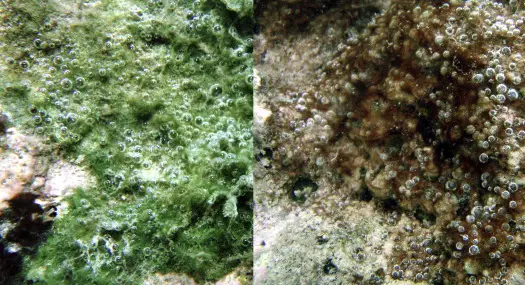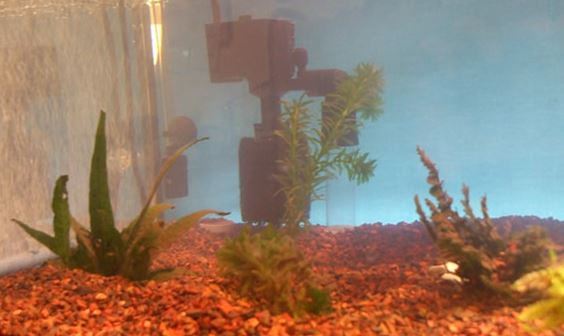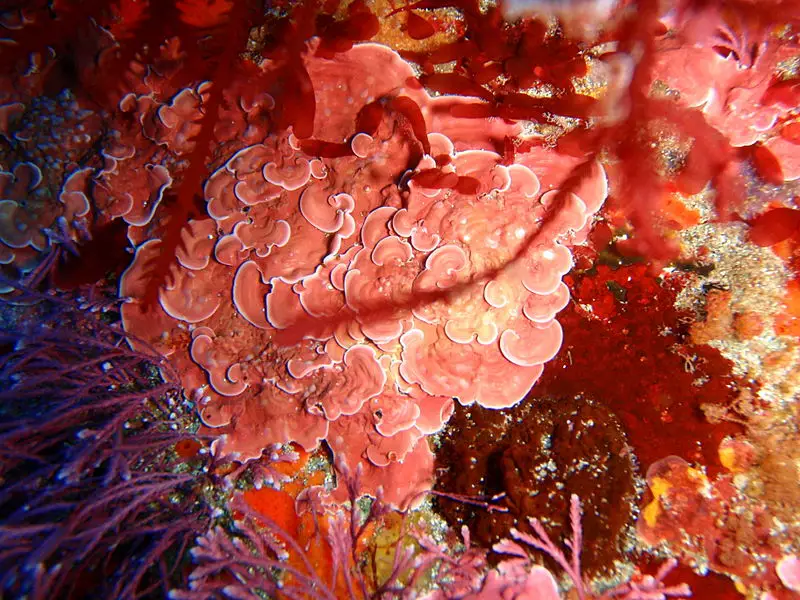Calothrix is a member of the cyanobacteria phylum that can look just like dinoflagellate or “dinos.” You can differentiate Calothrix from dinos based on the fact that dinoflagellate alga is typically longer and stringier.
The rest of this article will be dedicated to what Calothrix is, its causes, and how to get rid of it. By the end, you will be a master of this algae.
What is Calothrix algae?
The Calothrix genus is one of the many strains of pest algae that can grow in your tanks. However, they are not actually algae. Calothrix is a cyanobacteria which are classified as prokaryotes. Algae are eukaryotes. That said, it is simpler to refer to Calothrix as algae. Calothrix is able to photosynthesize just like algae.
If you have a microscope you can identify Calothrix fairly easily. It is typically green but can range from brown to black. It has simple cylindrical cells with a colorless sheath. The sheath can also be yellowish-brown. The filaments are often wider at the base and taper at the end.
If you do not have a microscope you will need to do your best to not confuse it with dinos. Both appear dark green or even brown. Both will also trap air bubbles within themselves. As mentioned above, dinoflagellate will be stringier than Calothrix. Dinos is often described as “snotty.”
Another difference can be observed when being siphoned. Dinos will tend to fall apart and become sludgelike. Calothrix will tend to separate from the substrate in patches like a mat.
In addition to the above physical characteristics, you can identify Calothrix by the parameters of your tank. Calothrix grows in particular situations as I will cover in the next section.
What causes Calothrix algae in a tank?
Calothrix has some particular conditions that it likes to grow in. Unfortunately, it does share these favorable conditions with other algae. Use every factor when attempting to identify algae.
Calothrix likes tanks that have high levels of phosphates and nitrogen in the water. If either of these levels becomes too high you will likely develop some Calothrix. Phosphates can come from replacement water, rotting food, and carbon. Nitrogen can come from fish urea which creates ammonia. The nitrogen cycle should be understood to keep it at decent levels.
Another element that Calothrix looks for is low flow areas. Places in your tank under high flow will be less likely to sprout this nuisance alga. If your tank’s inhabitants don’t enjoy high flow there isn’t much you can do in this area.
How to get rid of Calothrix algae?
As soon as you notice this algae and identify it you’re going to want to get rid of it. To do this you can choose from two options. You can go for a quick fix or attempt to deal with the cause. Both will work however, you may get the algae coming back if you don’t resolve the root cause.
Take into account the needs of any of your tank’s inhabitants when considering the potential solutions here.
The quick fix for Calothrix
If you want the Calothrix gone now you have a couple of options. These options are great for when you need the tank clean immediately. If you combine these methods with solutions in the next section you will be doing well.
- Brushing
- ChemiClean
- Blackout
The simplest quick fix is to simply siphon, brush, and net all of the algae you can. You may need to brush any larger pieces in your tank as Calothrix can be stubborn. Of course, this won’t get everything unless you are very precise. Not to mention the algae will eventually regrow.
What is more thorough by its nature is a chemical fix. Using ChemiClean will quickly and efficiently remove any Calothrix in your tank. This method combined with the previous will have your tank perfectly clean of pest algae.
The last of the quick fixes is a blackout treatment. Since Calothrix can photosynthesize like algae you can starve it to kill it. SImply cover the sides of your tank and turn off the light. Leave the tank this way for two days or however long it takes to kill the algae. Any plants you may have will do better with the lack of light than the algae will.
How to deal with the cause of Calothrix
It is possible you will get lucky and the quick fixes will work for the long term. However, it is not likely. You are better off removing the cause of the algae. While you can be reasonably sure of the cause it can take some trial and error to find the right fix.
As discussed above, Calothrix thrives in environments rich in phosphates and nitrogen. Your best bet is to reduce the phosphates in your tank. The ideal level is below 0.2 ppm.
You’ll want to start by identifying all the sources of phosphates in your tank. Some of the common sources include:
- Dying plant/algae matter
- Fish waste
- Dead fish
- Left-over food
- Tap water
Do what you can to reduce these sources. If that isn’t enough you can also bring in a refugium. A refugium with a specific strain of algae can remove the phosphates and nitrates from the water. Cheato macroalgae is one great possibility.
Between reducing the sources and starving the Calothrix you should have no problems getting rid of it for good. Be sure to take your time and be as thorough as possible.
What eats Calothrix algae?
Alternatively, you can introduce something that will eat the Calothrix for you. This solution would be one of the lowest effort solutions. However, there aren’t many fish that will eat this cyanobacterium.
That said, there are two types of snails that might do so. They are Trochus and Cerith snails. These snails are your best bet. If these snails don’t do the trick try Nerite or Chiton snails. If it seems like the snails are eating it but not fast enough, get more snails.



